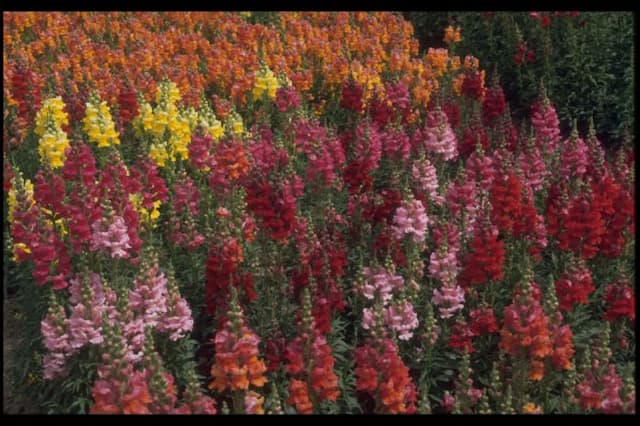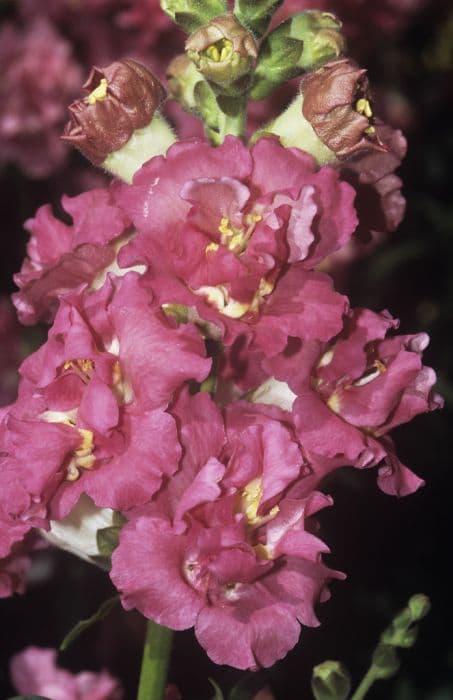White Beardtongue Penstemon hartwegii 'Albus'

ABOUT
Penstemon hartwegii 'Albus', commonly known as white beardtongue, is a perennial plant that exhibits an elegant form through its upright stems that bear tubular flowers. The blossoms are a pure white color, which provides a contrast with the green foliage beneath. The leaves of this variety are lance-shaped and arranged in opposite pairs along the stem. The white tubular flowers feature a prominent lower lip that provides a landing platform for pollinators such as bees and hummingbirds. These flowers are clustered in dense racemes at the top of the stems and have a somewhat bell-shaped appearance, with an open mouth that showcases its throat and stamens. Overall, white beardtongue provides a clean, crisp look in garden settings with its white blooms and lush greenery.
About this plant
 Names
NamesFamily
Plantaginaceae.
Synonyms
White Bedder Penstemon, White Beard Tongue, Albus Hartweg's Beardtongue, White Hartweg's Penstemon.
Common names
Penstemon hartwegii 'Albus'.
 Toxicity
ToxicityTo humans
Beardtongue is generally not considered toxic to humans. There are no well-documented cases of poisoning from ingesting Penstemon hartwegii 'Albus', commonly known as beardtongue. Therefore, consumption is unlikely to cause significant symptoms or consequences. Still, as with any plant, individuals may have varying sensitivities, and it's prudent to avoid ingesting parts of ornamental plants not meant for consumption.
To pets
Beardtongue is not commonly listed as a toxic plant to pets, which includes both dogs and cats. There is no widely available evidence suggesting that Penstemon hartwegii 'Albus', commonly known as beardtongue, would cause poisoning if ingested by pets. Therefore, it is unlikely to produce symptoms or have severe consequences if pets consume parts of this plant. However, each animal may react differently to various plants, so it is always best to prevent pets from eating ornamental plants.
 Characteristics
CharacteristicsLife cycle
Perennials
Foliage type
Deciduous
Color of leaves
Green
Flower color
White
Height
2-3 feet (60-90 cm)
Spread
1-2 feet (30-60 cm)
Plant type
Herb
Hardiness zones
6
Native area
Mexico
Benefits
 General Benefits
General Benefits- Attracts Pollinators: Penstemon hartwegii 'Albus', commonly known as Beardtongue, invites bees, butterflies, and hummingbirds, which are beneficial for pollination.
- Drought Resistant: Once established, Beardtongue has good drought tolerance, making it suitable for xeriscaping and water-wise gardens.
- Aesthetic Appeal: With its stunning white tubular flowers, it adds beauty and contrast to garden beds, borders, and containers.
- Cold Hardy: It can withstand cooler temperatures, which makes it a resilient choice for gardens in varying climates.
- Low Maintenance: Beardtongue generally requires minimal care, making it an excellent choice for busy gardeners or those seeking low-maintenance landscapes.
- Long Blooming Period: It has a lengthy flowering season that extends from late spring to early summer, providing extended visual interest.
- Native Plant: As a plant native to certain regions, it can contribute to the restoration of local habitat and support the local ecosystem.
- Deer Resistant: It is known to be resistant to browsing by deer, thus reducing the damage to the garden by wildlife.
- Versatility: Beardtongue can be used in a variety of garden styles, including wildflower gardens, rock gardens, and cottage gardens.
 Medical Properties
Medical PropertiesThis plant is not used for medical purposes.
 Air-purifying Qualities
Air-purifying QualitiesThis plant is not specifically known for air purifying qualities.
 Other Uses
Other Uses- Artistic Inspiration: The tall spires and pure white blooms of Penstemon hartwegii 'Albus', also known as White Beardtongue, can serve as a beautiful subject for botanical illustrations, watercolor paintings, and other artistic works.
- Educational Tool: Horticulture educators and biology teachers may use the White Beardtongue in lessons on pollination, discussing how the shape and color of its flowers are adapted to attract certain types of pollinators.
- Landscape Design: White Beardtongue is often used to add vertical interest to garden borders, cottage gardens, and rockeries, creating a pleasing visual contrast with lower-growing, ground-cover plants.
- Photography: The striking appearance of White Beardtongue makes it a favorite subject for photographers looking to capture the elegance and details of garden plants in their natural or cultivated environment.
- Garden Theme Creation: White Beardtongue can be central to a 'moon garden' where white and silver plants are chosen to shine in the moonlight and create a luminescent space during the evening hours.
- Culinary Garnish: Although not commonly eaten, the flowers of White Beardtongue may be used as an ornamental garnish for plates in high-end culinary presentations, provided they have been grown away from harmful pesticides.
- Frost Protection Indicator: White Beardtongue can act as an indicator plant in the garden; if it begins to suffer from cold damage, it may signal gardeners to protect more sensitive plants from impending frosts.
- Companion Planting: Gardeners sometimes use White Beardtongue alongside vegetables to attract beneficial insects or to act as a trap plant for certain pests that may otherwise attack nearby crops.
- Color Themed Events: The flowers of White Beardtongue can be used in floral arrangements for events that require a specific color theme, such as white weddings or other celebratory gatherings.
- Seasonal Crafts: The stems and flowers of White Beardtongue can be dried and used in wreaths, dried flower arrangements or other crafts where their long-lasting structure and color can be preserved.
Interesting Facts
 Feng Shui
Feng ShuiThe Beardtongue is not used in Feng Shui practice.
 Zodiac Sign Compitability
Zodiac Sign CompitabilityThe Beardtongue is not used in astrology practice.
 Plant Symbolism
Plant Symbolism- Endurance: Often found in rough terrains and withstands challenging conditions, the Penstemon, also known as Beardtongue, represents the ability to endure and thrive in face of difficulties.
- Diversity: With many different species and hybrids, Penstemons showcase a variety of appearances, symbolizing the beauty and strength in diversity.
- Health: Penstemons have been used by Native Americans for medicinal purposes, thus they are sometimes associated with health and healing.
- Attraction: Beardtongues are known for attracting hummingbirds and butterflies, symbolizing allure and the capacity to attract positive attention.
 Water
WaterFor the White Beardtongue, water deeply to ensure the soil is moist to a depth of several inches, then allow the topsoil to dry out slightly before the next watering. This plant prefers regular watering, especially during the growing season, and can typically be watered once a week, but this may vary depending on climate conditions. Provide approximately 1 gallon of water per plant, per week, during active growth, easing off during cooler months when the plant is not growing vigorously.
 Light
LightWhite Beardtongue thrives in full sun to partial shade, with a preference for at least 6 to 8 hours of direct sunlight daily. The best spot would be an area that gets ample morning sunlight with some protection from intense afternoon rays in hotter climates.
 Temperature
TemperatureWhite Beardtongue can tolerate a range of temperatures but grows best in conditions between 60°F and 75°F. It can survive minimum temperatures down to about 20°F, but it is not frost-hardy and should be protected from freezing conditions. Ideal growing conditions include warm days and cooler nights.
 Pruning
PruningPrune White Beardtongue to remove spent flower stalks and encourage a second bloom. Additionally, light pruning helps maintain a compact form and encourages new growth. Pruning is best done immediately after the first flush of flowers in early summer and can be repeated if the plant becomes leggy or after subsequent flowering.
 Cleaning
CleaningAs needed
 Soil
SoilWhite Beardtongue prefers a well-draining soil mix, rich in organic matter, with a pH ranging from neutral to slightly alkaline (pH 6.5-7.5). A mix containing loam, sand, and compost or aged manure, will provide the necessary drainage and nutrients for optimal growth.
 Repotting
RepottingWhite Beardtongue does not require frequent repotting and can typically be repotted every 2-3 years or when it outgrows its pot. Ensure that the new container has ample drainage holes to prevent waterlogged soil.
 Humidity & Misting
Humidity & MistingWhite Beardtongue is adaptable to a wide range of humidity levels, but it flourishes in moderate humidity. There's no need for high humidity, making it suitable for typical outdoor conditions without supplementary humidity.
 Suitable locations
Suitable locationsIndoor
Provide bright, indirect light and good air circulation.
Outdoor
Full sun to partial shade, protect from strong winds.
Hardiness zone
7-10 USDA
 Life cycle
Life cyclePenstemon hartwegii 'Albus', commonly known as White Beardtongue, begins its life cycle with seed germination, which is typically in the spring under adequate temperature and moisture conditions. Following germination, the seedlings establish themselves and develop a root system. As they mature, they form a rosette of leaves at the base, and the plant begins the vegetative growth phase where stems elongate and foliage expands. During the flowering stage in late spring to early summer, White Beardtongue produces tall spires of tubular white flowers, which are attractive to pollinators such as bees and hummingbirds. After pollination, seeds develop in small capsules and, once mature, are dispersed by wind or gravity. The plant may either die back in the winter, behaving as a perennial by re-emerging from the root system, or it completes its life cycle if it is grown as an annual, with new plants growing from the dispersed seeds the following season.
 Propogation
PropogationPropogation time
Spring-Early Summer
The Beardtongue, specifically Penstemon hartwegii 'Albus', is commonly propagated by seed. The best time to sow seeds is late winter to early spring, under cover, as this allows for a longer growing season. The popular method involves spreading the seeds thinly onto well-draining seed starting mix, gently pressing them into the soil but not covering them, as they need light to germinate. It's important to keep the soil evenly moist but not waterlogged. Germination can take 1 to 2 weeks at a temperature range between 60-70°F (15.6-21.1°C). Seedlings can then be transplanted outdoors after the danger of frost has passed and they've developed a few true leaves. They should be spaced about 12 inches (about 30 centimeters) apart to allow enough room for maturity.





![Snapdragon [Pretty in Pink]](/_next/image?url=https%3A%2F%2Fplants-admin.emdemapps.com%2Fimages%2Fplants%2F%2Fimages%2F604b5cb3b5385.png&w=640&q=75)



